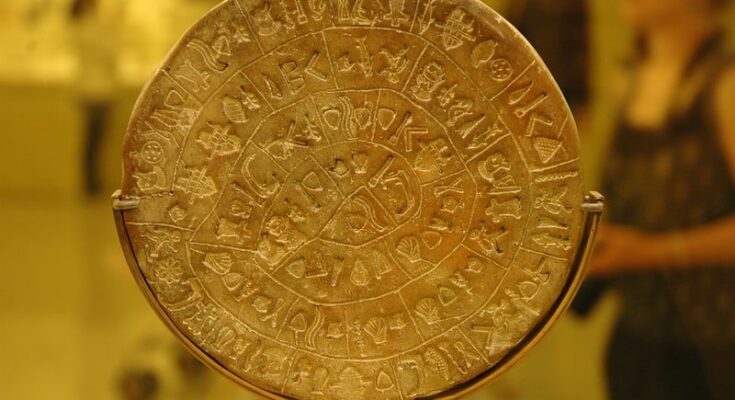
Of the most notable objects of the Minoan civilization is the Phaistos disk. It is a clay disk about six inches (15 centimeters) in diameter, with spiral inscriptions and approximately dates from the Middle or Late Minoan Bronze Age.
On both sides of the disc, 241 marks were made when the clay was still fresh. Some symbols clearly depict people, while others show animals, plants, weapons, tools, and other objects. There are also 61 other groups of marks that represent words.
The disk was discovered by Italian archaeologist Luigi Pernier in a room of a palace in Phaistos on July 3, 1908. The language on the disc has never been fully deciphered, and the symbols are not part of any known alphabet, ancient or modern.
One of archaeology’s greatest mysteries
Many scientists have attempted to explain the symbols on the Phaistos disk. Initially, some experts suggested the symbols were an early form of Greek language describing an animal sacrifice that took place in a temple.
Others have said it was written in Hittite or Egyptian. Alternatively, it might also be a prayer to a goddess or a funeral hymn.
A Luwian letter to Nestor
Another version of the content of the Phaistos disc is based on a study published in 2021. Researchers have concluded that the disc contains a letter sent from the Great King Tarhander of Arzaba in Anatolia to King Nestor of Pylos in Achaia (Mycenaean Greece).
According to the study, if we compare the writing of the disc with the Luwian hieroglyphics, we find that of the 47 signs, 31 can be associated with a corresponding Luwian hieroglyphic, which means that the remaining 16 signs have no matching counterpart.
Nevertheless, the researchers state that both the writing and the language of the disc have a local Cretan character. The most logical explanation, according to the study, is that the contents are an incoming letter from international correspondence (probably in a Luwian script), transcribed in Cretan script and dialect.
According to Starke’s analysis of a Hittite letter (KUB XXVI 91), the Aegean islands were received as a loan from Cadmus, the founder of Thebes, by the king of Arzaba on the occasion of the engagement of his daughter to that king.
Some words about the Minoans
The Minoans were a Bronze Age people who lived on Crete and other Aegean islands. The Minoan civilization flourished from 3,000 BC to 1450 BC and is famous for its art and architecture. It is believed to have inspired the early Mycenaean civilization on the Greek mainland.
In addition, the Minoan script was mainly Linear A and Cretan hieroglyphics. The name “Minoan” comes from the mythical king Minos, who kept the Minotaur in a labyrinth beneath the Minoan palace at Knossos, Crete until the beast was killed by the Athenian hero, Theseus.



